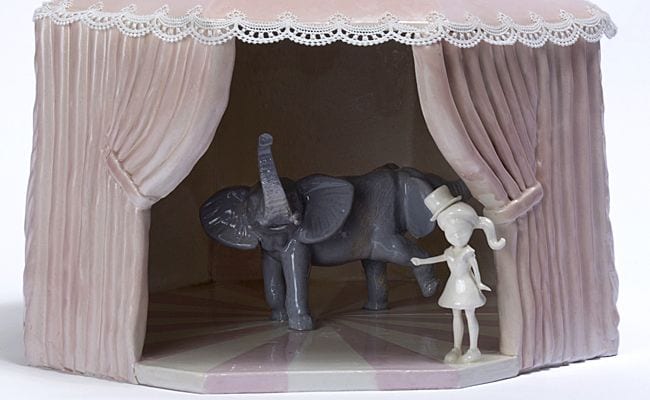Perhaps no cultural institution depends more on the naiveté and innocence of children than the circus. The big top is little more than an enclosed container that seals out the conventions of science and the rules of society, creating a menagerie of simulacra. Piercing this shell with any sense of reality eviscerates the illusion. This characteristic makes it very difficult to use as a subject for art.
Any rendition would take place on a continuum between two unappealing poles. The subject matter can be treated with snarky irony, poking fun at the absurdity of the illusion. On the other end, the subject can be treated with empty nostalgia. Either pole has a powerful gravity. Trying to avoid both requires not only a skilled hand, but also a strong critical eye. Danish ceramic artist Lea Nielsen’s surreal depictions of circus stories avoids either trap in the works selected for her recent exhibition Circus is in Town, VÆG Contemporary Art Gallery, Aalborg, Denmark.
A key element allows Nielsen to present sincere images without being overly sentimental. The artist’s surreal images read as being constructed from a child’s point of view. This is in part due to the fact that many of the figures are cast from children’s toys. Additionally, where Nielsen distorts illusion, she does so in a way that reflects an immature perception. Two details of Welcome to the Circus #1 (2015), a sculpture of a big top with a girl pulling back the curtain to reveal an elephant, illustrates this dynamic.
First, the elephant is made up of two heads and legs conjoined in the middle; it reads less as a mutation than how a child would perceive an elephant standing next to a mirror. The second detail is scale. The figure of the girl is almost as high as the elephant’s shoulder. The effect is like the sculpture was based on a photograph or painting, not an actual big top. It appears the artist bakes a two-dimensional perspective in a three dimensional piece. In a few other pieces, these two devices infuse the work with the sense that they are the dreams of a child. They are less depictions of an actual circus rather than how a child would imagine a circus to be.
This quality also plays an important part in Nielsen’s ability to avoid making the work too cynical. The subject of the circus is fertile ground for nihilistic irony. Broadly speaking, creating the sense where the images come from a child’s psyche creates an aura of sincerity. Whether true or not, people tend to view children as less coy and mannered than adults. This viewpoint also can change how specific details of each work are viewed. Nielson colors the big top in Welcome to the Circus #1 with a dingy pale pink color. The artist stacks folds of clay for each of the tent walls. The color and nature of this detail comes off as more flesh than fabric and more as an accident, not inferred. It is the aura of a child’s perception.

The Dancing Bear (2014), Photo: Erik Balle
There are times when Nielsen invests her images with a sense of irony. Far from being cynical, the artist always tempered with a sense of empathy. Dancing Bear (2015) epitomizes this dynamic. The image depicts a bear wearing a pink tutu, leaning against a tree and smoking a cigarette. A unicycle lies on the ground behind it. The image reads as a bear taking a quick smoke break between sets in his act. Essentially, the work tells the story of a worker who does what they can to enjoy a small break in the forced tedium of their job; something almost everyone can understand and identify with. In other pieces, Nielsen constructs tableaus that are far darker but still intended to provoke empathy.

The Girl With the Barrel Organ (2015), Photo: Erik Balle
There is an almost palpable sense of desperation in works like The Girl with Barrel Organ (2015) in which a small girl turns a crank as a monkey and deposits coins into a hat. Dingy brown and sulfuric chrome green are the two colors used to decorate this piece. These colors contrast with the bright colors of the artist’s other works. In Along the Rails (2015) a child in oversized shoes walks down train tracks trailed by a pig. Nielsen uses color to reflect this underscored narrative. Where many of her works are finished with pinks and yellows, these are much darker in color.

Along the Rails (2014), Photo: Erik Balle
One final formal element adds to the narratives Nielsen constructs. All of the works are finished with a shiny semi-translucent glaze. The effect of this small detail is like all of the work is finished with a thick lacquer, which magnifies the surrealist elements of many of the works. In several of the figures the thickness of the glaze all but obliterates the figures’ facial details. In Girl with Barrel Organ, the face is little more than a slightly discernible bump where the nose should be. This erasure of identity creates an eerie ghost-like quality. The finish gives all of the works a semi-fluid quality where the works appear to be in the process of melting. Again, this lends to the sense that the subject was constructed more in the author’s subconscious rather than the outer world.
The circus is more than just something that children outgrow. It is not just a kind of empty appetite like ketchup and Twinkies that gets replaced with more complicated and adult tastes. On a cultural level, it is an archetype of both pathos and rejection.In movies like Ingmar Bergman’s Sawdust and Tinsel (1953) and Frederico Fellini’s La Strada (1954), the circus is a receptacle for the damaged and dysfunctional. Like these directors, Nielsen’s reservoir of empathy allows her to avoid mocking the subjects in her work.


![Call for Papers: All Things Reconsidered [MUSIC] May-August 2024](https://www.popmatters.com/wp-content/uploads/2024/04/all-things-reconsidered-call-music-may-2024-720x380.jpg)



